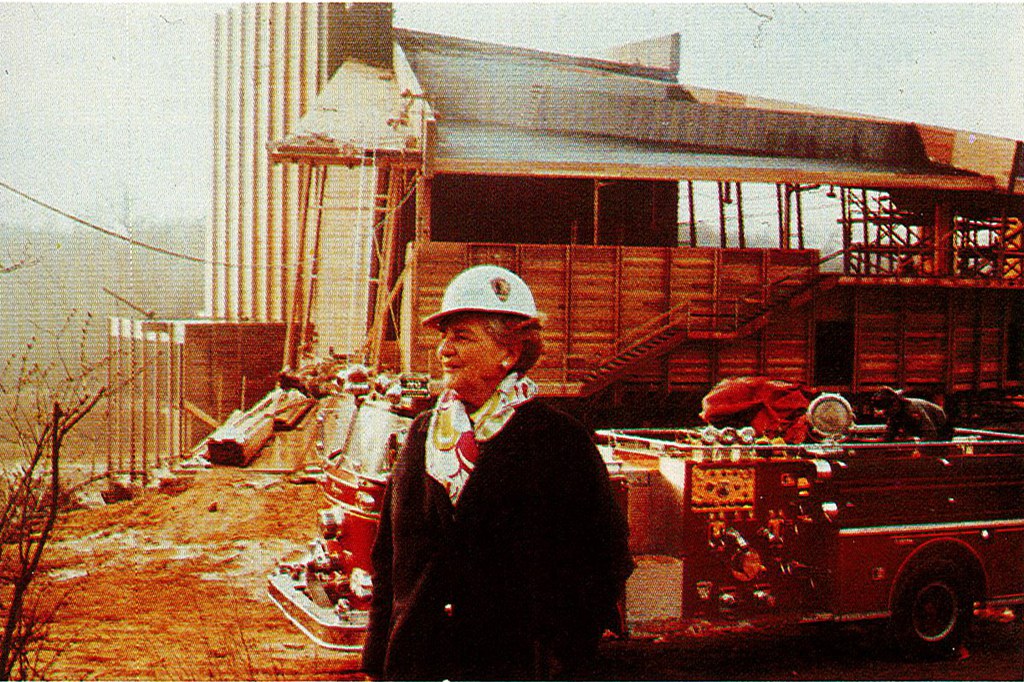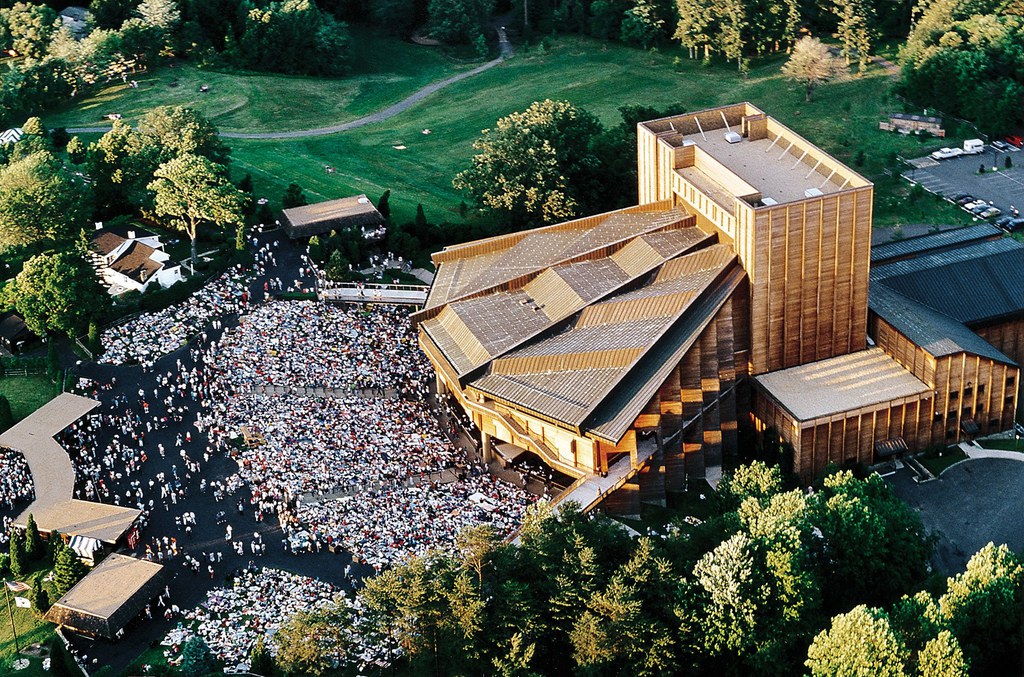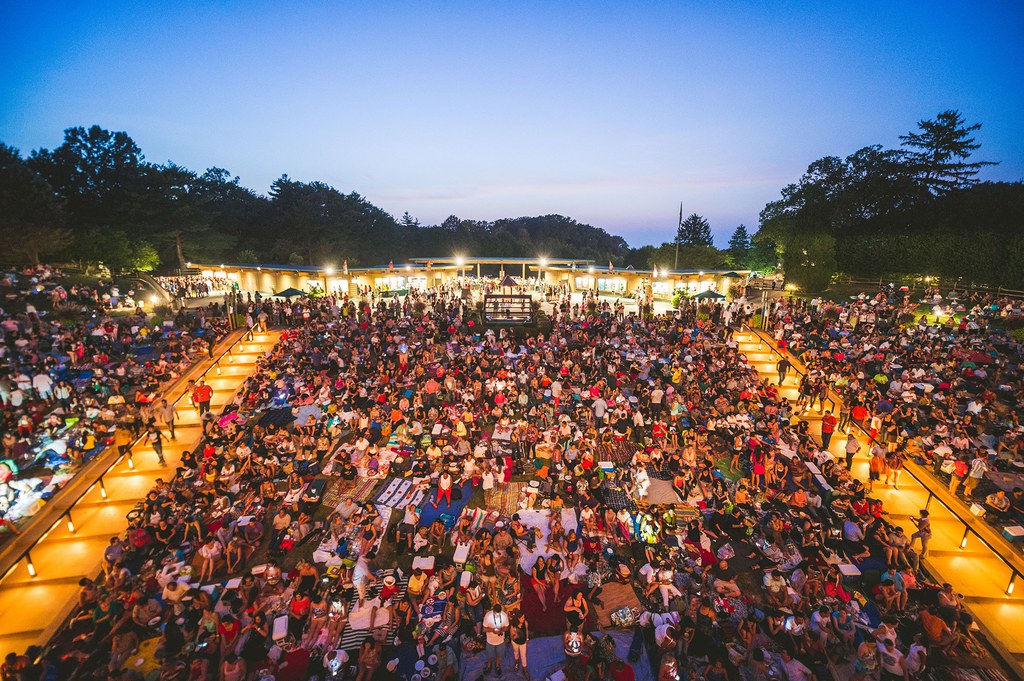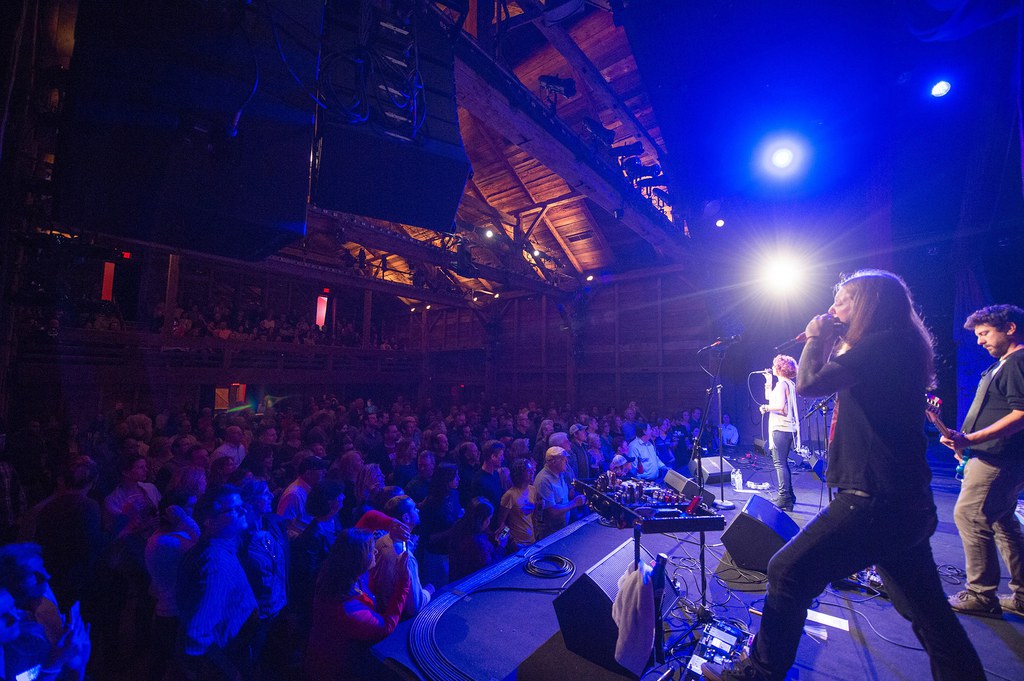
Wolf Trap National Park for the Performing Arts
Located on 117 acres of protected land in Fairfax County, Virginia, Wolf Trap National Park for the Performing Arts was established by Catherine Filene Shouse in 1966. A performance venue and center for cultural and natural heritage, it is operated jointly by the National Park Service and the nonprofit Wolf Trap Foundation in a unique public-private partnership.
Wolf Trap has a destiny. It reaches out for people asking that they restore their spirits at its theatre, on its hillsides, in the woods or by the stream.
Catherine Filene Shouse
Catherine (Kay) Filene (1896–1994) was born into a wealthy Jewish American Boston family.Claudia Levy, “Wolf Trap Founder Catherine Shouse Dies,” Washington Post, December 15, 1994, https://www.washingtonpost.com/archive/politics/1994/12/15/wolf-trap-founder-catherine-shouse-dies/339e5e7a-3095-4868-b946-8270c855eb1d/?utm_term=.7a899424525b. Her father, Lincoln Filene, was an heir to the Filene department store fortune.Paul Hume, “The Woman Who Built Wolf Trap,” Washington Post, Times Herald, July 1, 1971, C1. Although a shrewd businessman, Filene believed that capitalism needed to focus on individual welfare or it would be uprooted by radicalism. Consequently, he dedicated much of his life to social reform, supporting the suffragist movement and Franklin Delano Roosevelt’s New Deal.Yankl Stillman, “Jewish Currents, Edward Filene: Pioneer of Social Responsibility,” Jewish Currents, accessed January 13, 2018, http://www.jewishcurrents.org/2004-sept-stillman.htm. Catherine Filene’s mother, Therese Filene (née Weil), worked on causes including immigrant aid, disaster relief, and the founding of the Boston Music School Settlement. The Lincoln and Therese Filene Foundation still operates today, providing grants to nonprofits that advance philanthropic goals.“Founders’ Biographies,” Filene Foundation, accessed January 13, 2018, https://www.filenefoundation.org/lincoln-therese.
This environment of socially responsible wealth influenced Catherine Filene’s later life. At Wheaton College, she promoted female empowerment in the workplace by organizing the Intercollegiate Vocational Guidance Association, which would later become the Institute of Women’s Professional Relations in 1929. After graduating in 1918, she worked for the Women’s Division of the Department of Labor’s U.S. Employment service. In 1920, she wrote a book entitled Careers for Women, the first vocational manual of its kind, which was reprinted in 1974.Eve Carr and Millard Carr, The Wolf Trap Story (Vienna, Va.: Wolf Trap Associates, 1977), 20.
“Perhaps the Grandest Woman in America”
Former Secretary of the Navy J. William Middendorf called Catherine Shouse “perhaps the grandest woman in America,” a description he used to underscore her long and productive career in the public sector. She became the first woman to receive a master’s degree in education from Harvard University in 1923, and, in 1926, she was appointed as chairman of the first federal women’s prison, where she instituted job-training and rehabilitation programs. She was heavily involved in Democratic politics, becoming the first woman on the Massachusetts Democratic Committee and the state’s first female representative at the National Democratic Committee.Carr and Carr, Wolf Trap Story, 19–20.
In 1929, Catherine Filene married Jouett Shouse, a former congressman who served as chair of the Democratic National Executive Committee. After the Second World War, the couple visited Germany and became interested in fostering social action overseas. From 1947 until the 1960s, Catherine Shouse lent her fundraising acumen to the General Clay Fund, which supported army outreach by teaching youth about democracy in postwar Germany. She also helped to raise relief funds during the 1956 Hungarian refugee crisis. Her lifelong political involvement and philanthropy earned Shouse many honors, including the Presidential Medal of Freedom and the rank of Dame Commander of the British Empire.

Later in life, Shouse dedicated much of her time and resources to the performing arts. She organized the first chamber music concerts at the Phillips Collection in Washington, D.C.,Levy, “Wolf Trap Founder.” and, in 1962, the first International Jazz Festival. She also spent decades on the boards of the John F. Kennedy Center for the Performing Arts and the National Symphony Orchestra.Susan Ware, “Shouse, Catherine Filene,” in Notable American Women: A Biographical Dictionary Completing the Twentieth Century (Cambridge, Mass.: Belknap Press of Harvard University Press, 2004), 590–91. However, her influence on the performing arts is best known through the cause to which she dedicated the last thirty years of her life: Wolf Trap National Park for the Performing Arts.
A Refuge from City Life
Shortly after marrying, the Shouses acquired a fifty-three-acre farm located on Wolf Trap Run in Northern Virginia and named it Wolf Trap Farm.The land that would become Wolf Trap was part of the “Old Dominion” of the Virginia Colony settled by the English in the seventeenth century. The park’s name pays homage to this era, when wolves were a threat to human settlements, and the colonial government offered large rewards to individuals for trapping and killing wolves. J. M. Warner gave the name “wolftrap” to a branch of the Potomac’s Difficult Run tributary in 1739, and the name endured. Carr and Carr, Wolf Trap Story, 10. They ran it as a working farm, raising crops and animals. She recalled of these days: “We soon developed a partnership with nature, and we were only too happy to share it with our friends.”Carr and Carr, Wolf Trap Story, 12. Indeed, Wolf Trap served as a retreat for many of the nation’s political leaders, and every June the farm hosted a “Have-Fun Carnival” for charity, with cabinet members and senators serving as carnival barkers and sideshow acts.Carr and Carr, Wolf Trap Story, 12. After the Second World War, Wolf Trap hosted diplomats who were participating in the Dumbarton Oaks Conversations that led to the establishment of the United Nations.“Find Your Park,” Wolf Trap, accessed February 28, 2018, http://allaccess.wolftrap.org/2016/05/23/find-your-park.
Establishing Wolf Trap National Park for the Performing Arts
By the 1960s, the Washington metropolitan area had spread into northern Virginia and southern Maryland. This development threatened the idyllic environs of Wolf Trap Farm, especially with the construction of the Dulles International Airport starting in 1958. The airport’s developers used eminent domain to construct the Dulles Toll Road, which bifurcated Wolf Trap, separating a small southeast section from the rest of the farm. Fearing that Wolf Trap would be further subdivided if she did not act to protect it, Shouse decided to donate the farm to the National Park Service in 1966.Carr and Carr, Wolf Trap Story, 13.
Shouse’s intent in donating Wolf Trap was to “save a bit of natural, unspoiled land on the Virginia side of the Potomac River for the relaxation and recreation of people of all ages.”Carr and Carr, Wolf Trap Story, 13. She also wanted to make Wolf Trap a home for culture and art. She desired to give visitors “a peaceful and historic setting where they could have an opportunity to listen to the works of great composers while attending performances of opera, ballet, jazz, theater, or other forms of the performing arts.”Carr and Carr, Wolf Trap Story, 13.

Congress accepted Shouse’s gift of sixty acres to establish the first and only national park for the performing arts in the United States. Since its inception, the property has grown to 117 acres, owned by the federal government and managed by the National Park Service. However, because its main mission is land management, the National Park Service was not equipped to run Wolf Trap as a performing arts venue. Therefore, Shouse also established the nonprofit Wolf Trap Foundation to oversee the administration of its educational and artistic programs and engage in fundraising. Such a private-public partnership remains unique among the United States’ national parks.
Mission, Venues, and Educational Programs
The mission of the Wolf Trap Foundation is “to present and create excellent and innovative performing arts programs for the enrichment, education, and enjoyment of diverse audiences and participants.”“Mission,” Wolf Trap, accessed January 14, 2018, http://www.wolftrap.org/about/mission. It advances this mission at three performance venues: The mainstage at Wolf Trap, the Filene Center, an outdoor amphitheater that seats seven thousand people and hosts eighty performances a year; The Barns, two eighteenth-century barns from upstate New York that were brought to the site and refurnished; and the Children’s Theatre-in-the-Woods.“Mission,” Wolf Trap.
Wolf Trap also hosts educational programs for local youth, especially those from underprivileged areas without access to performing arts or nature. The Center for Education runs field trips and music classes for students and professional enrichment workshops for arts educators. The Wolf Trap Institute for Early Learning through the Arts focuses on early childhood education, with a national network of programs placing artists in classrooms to engage with students and train teachers to incorporate arts into education.“Education,” Wolf Trap, accessed January 13, 2018, http://www.wolftrap.org/education.



Conclusion
Catherine Filene Shouse remained deeply involved with Wolf Trap from its inception until her death at the age of 99 in 1994.Levy, “Wolf Trap Founder.” The legacy of her vision and philanthropy is the enduring, unique partnership of government and foundation that provides the public access to both a performing arts and education venue and a national recreational park. In a 1997 letter, written six years after the opening of the Filene Center, Shouse stated, “Wolf Trap has a destiny. It reaches out for people asking that they restore their spirits at its theatre, on its hillsides, in the woods or by the stream. And it can grow in scope and meaningfulness to the extent of man’s imagination and support.”Catherine Filene Shouse, May 9, 1977, quoted in Carr and Carr, Wolf Trap Story, 3.
Profile by Julian Rauter, 2018 Wintersession student, and Faye Yan Zhang, 2017–2018 Dumbarton Oaks Humanities Fellow.
